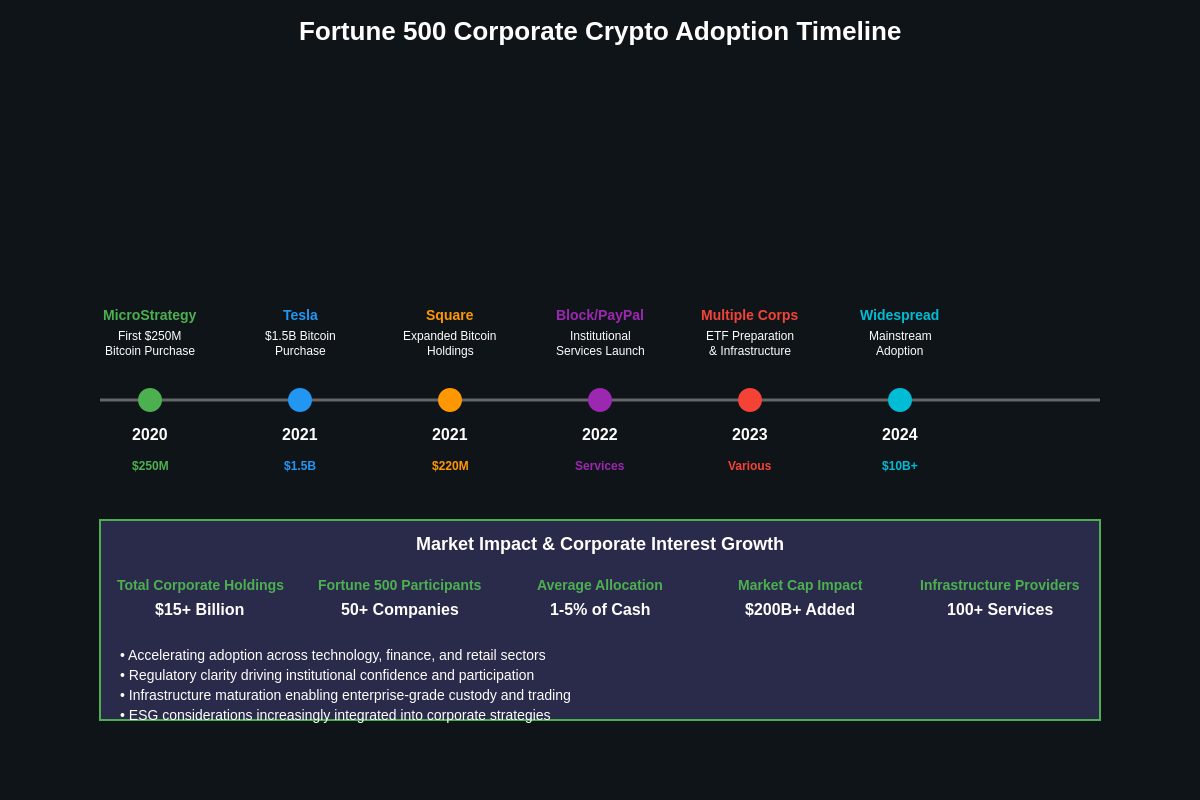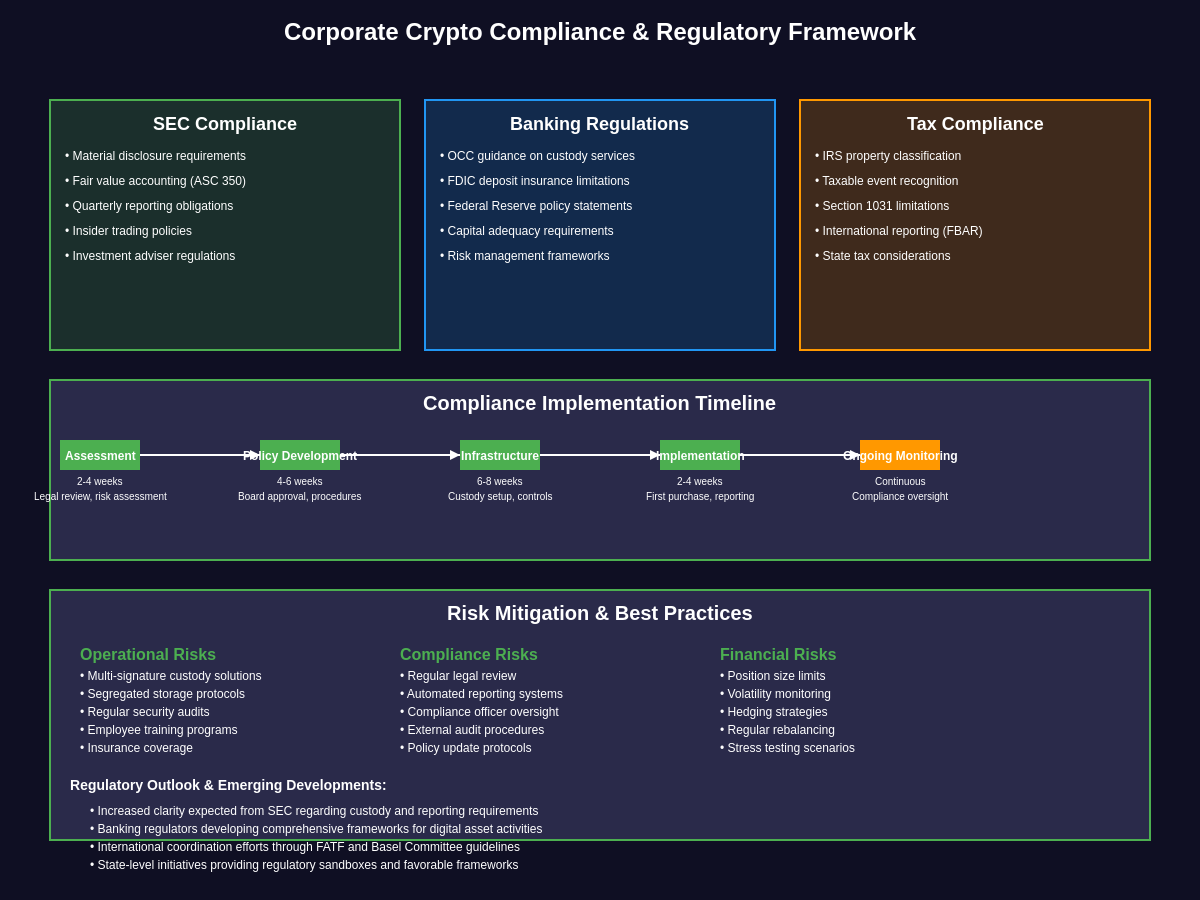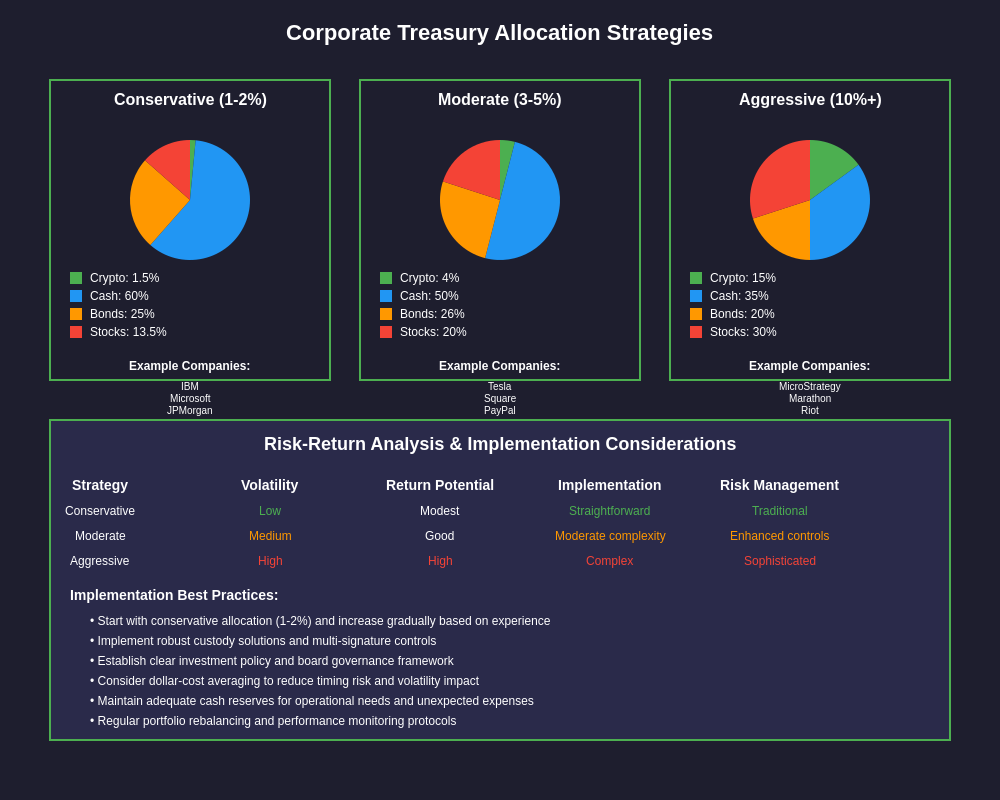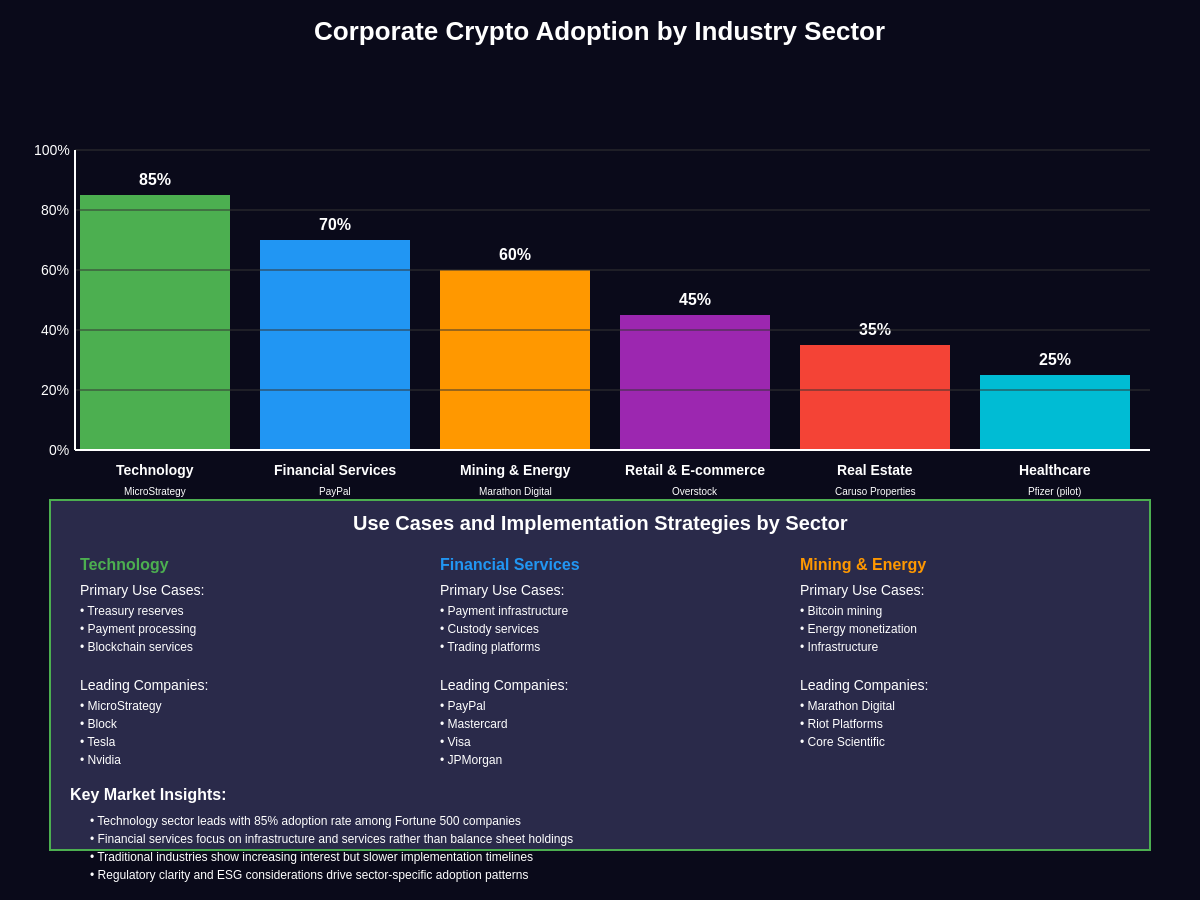The Corporate Crypto Revolution Unfolds

The landscape of corporate finance is experiencing a seismic shift as Fortune 500 companies increasingly embrace cryptocurrency as a legitimate asset class for their treasury reserves. What began as a fringe investment strategy championed by a handful of forward-thinking executives has evolved into a mainstream financial practice that is reshaping how America’s largest corporations manage their cash holdings and hedge against traditional economic uncertainties. This institutional adoption represents far more than a technological trend; it signals a fundamental transformation in how corporations view digital assets as stores of value, operational tools, and strategic investments.
The movement toward corporate cryptocurrency adoption gained significant momentum during the COVID-19 pandemic, when unprecedented monetary stimulus and near-zero interest rates forced treasury managers to seek alternative stores of value beyond traditional cash holdings. As central banks around the world implemented quantitative easing programs that effectively devalued fiat currencies, corporate treasurers began recognizing Bitcoin and other cryptocurrencies as potential hedges against inflation and currency debasement. This shift in perspective, combined with improving cryptocurrency infrastructure and regulatory clarity, created the perfect storm for institutional adoption.
Pioneering Companies Leading the Charge

MicroStrategy stands as perhaps the most prominent example of corporate cryptocurrency adoption, with the business intelligence company transforming its entire treasury strategy around Bitcoin accumulation. Under the leadership of CEO Michael Saylor, MicroStrategy began purchasing Bitcoin in August 2020 and has since amassed one of the largest corporate Bitcoin holdings in the world. The company’s aggressive Bitcoin strategy, which involves using debt financing and corporate cash flows to purchase additional Bitcoin, has effectively turned MicroStrategy into a Bitcoin proxy stock that many institutional investors use to gain Bitcoin exposure through traditional equity markets.
Tesla’s entry into the cryptocurrency market in early 2021 marked a watershed moment for institutional adoption, as the electric vehicle manufacturer announced a $1.5 billion Bitcoin purchase and briefly accepted Bitcoin as payment for its vehicles. While Tesla later suspended Bitcoin payments due to environmental concerns and reduced its Bitcoin holdings, CEO Elon Musk’s public endorsement of cryptocurrency legitimized digital assets in the eyes of many institutional investors. The company’s continued interest in cryptocurrency, including its substantial Dogecoin holdings and ongoing acceptance of Dogecoin for merchandise purchases, demonstrates the evolving nature of corporate cryptocurrency strategies.
Square, now known as Block, pioneered the integration of cryptocurrency into both corporate treasury management and operational business models. The fintech company not only holds Bitcoin on its balance sheet but has built an entire ecosystem of cryptocurrency services, including the Cash App’s Bitcoin buying functionality and its Bitcoin hardware wallet initiatives. Under former CEO Jack Dorsey’s leadership, Square demonstrated how companies could simultaneously benefit from cryptocurrency price appreciation while building revenue streams around digital asset services.
Traditional financial institutions have also embraced cryptocurrency in various forms, with companies like PayPal, Mastercard, and Visa developing cryptocurrency payment processing capabilities and exploring digital asset custody services. These companies recognize that cryptocurrency adoption represents both a potential threat to traditional payment systems and an opportunity to capture value in the evolving digital payments landscape. Their involvement has been crucial in building the infrastructure necessary for broader corporate adoption.
Treasury Management Revolution
The incorporation of cryptocurrency into corporate treasury strategies represents a fundamental shift in how companies approach cash management and capital allocation. Traditional corporate treasury functions focused primarily on capital preservation, liquidity management, and modest yield generation through money market funds and short-term government securities. However, the prolonged period of ultra-low interest rates that followed the 2008 financial crisis and intensified during the COVID-19 pandemic rendered these traditional approaches increasingly inadequate for maintaining purchasing power over time.
Cryptocurrency offers corporate treasurers an alternative that combines the potential for significant appreciation with the liquidity characteristics necessary for effective cash management. Bitcoin, in particular, has attracted corporate attention due to its fixed supply schedule, which creates scarcity dynamics that many executives view as superior to fiat currencies subject to unlimited creation by central banks. Companies analyzing Bitcoin’s price performance and market trends have observed its potential to serve as a hedge against currency debasement and inflation.
The decision to add cryptocurrency to corporate balance sheets typically involves extensive analysis of risk management, accounting treatment, and regulatory compliance considerations. Companies must develop sophisticated frameworks for determining appropriate allocation percentages, establishing purchase and selling criteria, and managing the volatility inherent in cryptocurrency markets. Many corporations start with modest allocations, often representing 1-5% of total cash holdings, before potentially increasing exposure as they gain confidence and experience with digital asset management.
Accounting and Regulatory Considerations

The accounting treatment of cryptocurrency holdings presents both challenges and opportunities for corporate adopters. Under current U.S. Generally Accepted Accounting Principles, cryptocurrencies are typically classified as indefinite-lived intangible assets, which means companies must test them for impairment each reporting period and recognize decreases in value immediately, while increases in value can only be recognized upon sale. This accounting treatment can create earnings volatility that some corporations find challenging to manage, particularly in periods of significant cryptocurrency price fluctuations.
Despite these accounting complexities, many companies have concluded that the potential benefits of cryptocurrency holdings outweigh the financial reporting challenges. Some corporations have advocated for changes to accounting standards that would allow cryptocurrencies to be treated more like marketable securities, with unrealized gains and losses flowing through other comprehensive income rather than directly impacting earnings. These potential accounting changes could significantly increase corporate adoption by reducing the earnings volatility associated with cryptocurrency holdings.
Regulatory considerations play a crucial role in corporate cryptocurrency adoption decisions, as companies must navigate an evolving patchwork of federal and state regulations governing digital assets. The Securities and Exchange Commission’s ongoing efforts to clarify which cryptocurrencies constitute securities, the Treasury Department’s anti-money laundering requirements, and various state-level licensing requirements all influence how corporations structure their cryptocurrency strategies. Companies must also consider international regulatory developments, particularly as they relate to overseas operations and cross-border transactions.
Risk Management and Due Diligence

Corporate cryptocurrency adoption requires sophisticated risk management frameworks that address the unique characteristics of digital assets. Unlike traditional financial assets, cryptocurrencies operate in markets that trade 24/7, exhibit high volatility, and lack some of the regulatory protections available in traditional securities markets. Companies must develop comprehensive policies governing everything from custody solutions and private key management to transaction authorization and market risk monitoring.
Cybersecurity considerations represent a critical component of corporate cryptocurrency risk management, as the irreversible nature of blockchain transactions means that security breaches can result in permanent asset losses. Companies typically implement multi-signature wallet solutions, cold storage protocols, and comprehensive insurance coverage to protect their digital asset holdings. Many corporations also engage specialized cryptocurrency custody providers that offer institutional-grade security measures and regulatory compliance capabilities.
The due diligence process for corporate cryptocurrency adoption often involves extensive analysis of market dynamics, technological risks, and competitive positioning. Companies must evaluate not only the investment merits of specific cryptocurrencies but also the operational implications of holding digital assets, including impacts on internal controls, audit procedures, and stakeholder communications. This comprehensive approach helps ensure that cryptocurrency adoption aligns with broader corporate strategies and risk tolerance levels.
Market Impact and Price Dynamics

The entry of Fortune 500 companies into cryptocurrency markets has had profound effects on price dynamics and market structure. Corporate purchases, particularly large acquisitions by companies like MicroStrategy and Tesla, have contributed to significant price appreciation events and increased overall market legitimacy. These institutional flows provide a stabilizing influence during market downturns and contribute to reduced volatility over time as corporate treasuries tend to hold assets for longer periods than individual retail investors.
The presence of corporate buyers has also influenced cryptocurrency market microstructure, with over-the-counter trading desks and institutional trading platforms experiencing increased activity. These developments have improved market liquidity and price discovery mechanisms while reducing the impact of large transactions on spot market prices. Professional traders monitoring cryptocurrency market movements and institutional flows can observe how corporate adoption has contributed to more mature market dynamics.
Corporate adoption has created positive feedback loops that encourage additional institutional participation, as each new corporate announcement validates the asset class and reduces perceived adoption risks for other companies. This network effect has been particularly pronounced in specific industry sectors, where early adopters have influenced competitors and partners to explore similar strategies. The resulting momentum has contributed to what many observers characterize as an institutional adoption super-cycle that could continue for years.
Sector-Specific Adoption Patterns

Different industry sectors have exhibited varying patterns of cryptocurrency adoption based on their unique business models, regulatory environments, and customer bases. Technology companies have generally been early adopters, leveraging their technical expertise and innovation-focused cultures to explore cryptocurrency opportunities. These companies often view digital assets not only as treasury investments but also as enablers of new business models and revenue streams.
Financial services companies have approached cryptocurrency adoption with a focus on service provision and infrastructure development rather than balance sheet accumulation. Banks, payment processors, and investment management firms have developed cryptocurrency trading, custody, and advisory services while maintaining more conservative approaches to holding digital assets as corporate investments. This sector’s adoption has been crucial in building the institutional infrastructure necessary for broader corporate participation.
Retail and consumer goods companies have explored cryptocurrency adoption primarily through payment acceptance and customer engagement initiatives rather than significant balance sheet allocations. These companies recognize cryptocurrency’s potential to attract younger, technology-savvy customers while providing alternative payment options that could reduce transaction costs and improve international commerce capabilities.
ESG Considerations and Sustainability
Environmental, social, and governance considerations have become increasingly important factors in corporate cryptocurrency adoption decisions. The energy consumption associated with Bitcoin mining has prompted many companies to carefully evaluate the sustainability implications of their digital asset strategies. Some corporations have implemented specific criteria requiring that their Bitcoin holdings be supported by renewable energy sources or have chosen to focus on more energy-efficient cryptocurrencies.
Tesla’s decision to temporarily suspend Bitcoin payments due to environmental concerns highlighted how ESG considerations can influence corporate cryptocurrency policies. This development prompted many companies to develop more sophisticated frameworks for evaluating the environmental impact of their digital asset holdings and to engage with the cryptocurrency community on sustainability initiatives. The ongoing transition of Bitcoin mining toward renewable energy sources and the development of more energy-efficient consensus mechanisms continue to address these concerns.
Social responsibility considerations include evaluating how cryptocurrency adoption aligns with corporate values around financial inclusion, privacy, and technological democratization. Many companies view cryptocurrency as a tool for expanding financial services access to underserved populations and enabling more efficient cross-border transactions. These social benefits often factor into corporate adoption decisions alongside financial considerations.
Infrastructure Development and Custody Solutions
The growth of corporate cryptocurrency adoption has driven significant investment in institutional-grade infrastructure and custody solutions. Traditional financial institutions, including major banks and asset managers, have developed cryptocurrency custody services that meet the regulatory and operational requirements of large corporations. These services typically include segregated storage, comprehensive insurance coverage, and integration with existing corporate banking and treasury management systems.
The development of regulated cryptocurrency exchanges and over-the-counter trading platforms has provided corporations with the market access and execution capabilities necessary for large-scale digital asset transactions. These platforms offer features specifically designed for institutional users, including advanced order types, settlement options, and regulatory compliance tools that facilitate corporate adoption.
Payment infrastructure developments have also played a crucial role in enabling corporate cryptocurrency adoption, with companies like Mastercard, Visa, and PayPal building cryptocurrency payment processing capabilities that allow businesses to accept digital assets without directly handling the underlying technology. These solutions reduce operational complexity while providing exposure to cryptocurrency payment flows and customer bases.
International Perspectives and Global Adoption
Corporate cryptocurrency adoption extends beyond U.S. Fortune 500 companies to include major corporations worldwide, each navigating their respective regulatory environments and market conditions. European companies have generally taken more cautious approaches due to stricter regulatory frameworks, but many have developed comprehensive cryptocurrency strategies focused on compliance and risk management. The European Union’s Markets in Crypto-Assets regulation provides a clearer regulatory framework that may accelerate corporate adoption in the region.
Asian corporations have exhibited varied approaches to cryptocurrency adoption, with companies in countries like Japan and Singapore leading adoption efforts due to clearer regulatory frameworks. Chinese companies have largely avoided cryptocurrency holdings due to domestic restrictions, but many maintain exposure through international subsidiaries and blockchain technology investments. The diverse regulatory landscape across Asia creates both opportunities and challenges for multinational corporations developing global cryptocurrency strategies.
Latin American companies have shown increasing interest in cryptocurrency adoption as a hedge against local currency instability and inflation. Companies operating in countries experiencing significant currency devaluation have viewed Bitcoin and other cryptocurrencies as potential stores of value that can preserve purchasing power better than domestic currencies. This regional adoption trend highlights how cryptocurrency can serve different corporate objectives based on local economic conditions.
Future Outlook and Emerging Trends
The trajectory of corporate cryptocurrency adoption suggests continued growth as infrastructure improves, regulatory clarity increases, and more companies gain experience with digital asset management. Emerging trends include the development of cryptocurrency-focused investment funds that allow corporations to gain diversified digital asset exposure without directly managing individual cryptocurrencies. These investment vehicles provide professional management and risk diversification while maintaining the treasury benefits of cryptocurrency exposure.
Central bank digital currencies represent another significant development that could influence corporate adoption patterns. As governments develop digital versions of their national currencies, corporations may gain access to more stable, regulated digital assets that combine the efficiency benefits of cryptocurrency with the stability of traditional fiat currencies. The interaction between corporate cryptocurrency holdings and CBDCs will likely shape future adoption strategies.
The evolution of cryptocurrency derivatives and structured products provides corporations with additional tools for managing cryptocurrency exposure and implementing sophisticated hedging strategies. Advanced trading platforms and analytical tools enable corporate treasurers to develop more nuanced approaches to cryptocurrency portfolio management that can better align with specific risk tolerance levels and investment objectives.
Integration with Traditional Finance
The integration of cryptocurrency with traditional financial systems continues to deepen as banks, insurance companies, and other financial institutions develop products and services that bridge the gap between digital assets and conventional finance. This integration includes cryptocurrency lending and borrowing platforms that allow corporations to generate yield on their digital asset holdings or access liquidity without selling cryptocurrency positions.
The development of cryptocurrency index funds and exchange-traded funds provides corporations with additional avenues for gaining digital asset exposure through familiar investment vehicles. These products often offer lower operational complexity than direct cryptocurrency ownership while providing diversified exposure to the digital asset ecosystem. The continued evolution of these investment products will likely accelerate corporate adoption by reducing implementation barriers.
Insurance products specifically designed for cryptocurrency holdings have become increasingly sophisticated, offering coverage for everything from custody risks and key management failures to exchange hacks and regulatory changes. These insurance solutions address many of the operational risks that have historically deterred corporate adoption and provide the risk management tools necessary for large-scale institutional participation.
Competitive Advantages and Strategic Implications
Companies that successfully implement cryptocurrency strategies often gain competitive advantages in multiple areas, including treasury management, customer attraction, and technological innovation. Early adopters have demonstrated that cryptocurrency holdings can significantly outperform traditional cash management strategies during periods of currency debasement and inflation. These performance benefits can translate into improved financial results and enhanced shareholder value creation.
Customer-facing benefits of cryptocurrency adoption include the ability to attract younger, technology-oriented demographics and provide innovative payment options that differentiate companies from competitors. Businesses that accept cryptocurrency payments often report increased customer engagement and expanded market reach, particularly in international markets where traditional payment methods may be less accessible or more expensive.
The technological capabilities developed through cryptocurrency adoption often enable companies to explore other blockchain-based innovations, including supply chain management, smart contracts, and decentralized finance applications. These broader technological benefits can create long-term competitive advantages that extend well beyond the direct financial impact of cryptocurrency holdings.
Risk Mitigation Strategies
Successful corporate cryptocurrency adoption requires comprehensive risk mitigation strategies that address the unique challenges associated with digital assets. Portfolio diversification remains a fundamental principle, with most companies limiting cryptocurrency exposure to modest percentages of total assets while maintaining traditional cash management practices for operational liquidity needs. This balanced approach allows companies to capture cryptocurrency benefits while maintaining financial stability.
Volatility management strategies include systematic rebalancing protocols, hedging programs using derivatives, and dynamic allocation models that adjust cryptocurrency exposure based on market conditions and corporate needs. Some companies implement dollar-cost averaging approaches for accumulating cryptocurrency positions, which can reduce the impact of short-term price volatility while building exposure over time.
Operational risk mitigation involves implementing robust internal controls, regular security audits, and comprehensive staff training programs. Companies typically establish clear policies governing cryptocurrency transactions, custody procedures, and reporting requirements to ensure consistent risk management across all digital asset activities. These operational safeguards are essential for maintaining the integrity of cryptocurrency holdings and preventing losses due to human error or security breaches.
Shareholder and Stakeholder Communications
Effective communication with shareholders and stakeholders represents a critical component of successful corporate cryptocurrency adoption. Companies must clearly articulate their cryptocurrency strategies, explain the rationale for digital asset investments, and provide regular updates on holdings and performance. This transparency helps build confidence among investors and demonstrates management’s thoughtful approach to cryptocurrency adoption.
Educational initiatives often accompany corporate cryptocurrency announcements, as many shareholders and stakeholders may be unfamiliar with digital assets and their potential benefits and risks. Companies typically provide detailed explanations of cryptocurrency fundamentals, risk management approaches, and strategic objectives to help stakeholders understand and evaluate their digital asset strategies.
Regular reporting and disclosure practices include quarterly updates on cryptocurrency holdings, market value changes, and any significant transactions or policy modifications. These communications help maintain transparency and allow stakeholders to monitor the progress and impact of corporate cryptocurrency strategies over time.
The Path Forward for Corporate Crypto
As Fortune 500 companies continue to evaluate and implement cryptocurrency strategies, the corporate adoption landscape will likely evolve to include more sophisticated approaches to digital asset management and integration. The experiences of early adopters provide valuable lessons for companies considering cryptocurrency adoption, while ongoing infrastructure development and regulatory clarification continue to reduce implementation barriers and risks.
The maturation of cryptocurrency markets and the development of institutional-grade tools and services suggest that corporate adoption will become increasingly mainstream over the coming years. Companies that develop thoughtful, well-executed cryptocurrency strategies today may find themselves better positioned to navigate future economic uncertainties and capitalize on the continued evolution of digital finance.
The transformation of corporate treasury management through cryptocurrency adoption represents more than a temporary trend; it signals a fundamental shift toward more dynamic, technology-enabled approaches to capital allocation and risk management. As more Fortune 500 companies embrace digital assets, the cumulative effect will likely accelerate the mainstream adoption of cryptocurrency while demonstrating its viability as a legitimate component of corporate financial strategy.
Disclaimer: This article is for educational and informational purposes only and should not be construed as financial or investment advice. Cryptocurrency investments carry significant risks, including the potential for total loss of capital and high volatility. Corporate treasury decisions should be made in consultation with qualified financial advisors and legal counsel. The regulatory landscape for cryptocurrencies continues to evolve, and companies should carefully consider all applicable regulations and compliance requirements. The author and publisher are not responsible for any financial losses that may occur from acting on the information provided in this article.